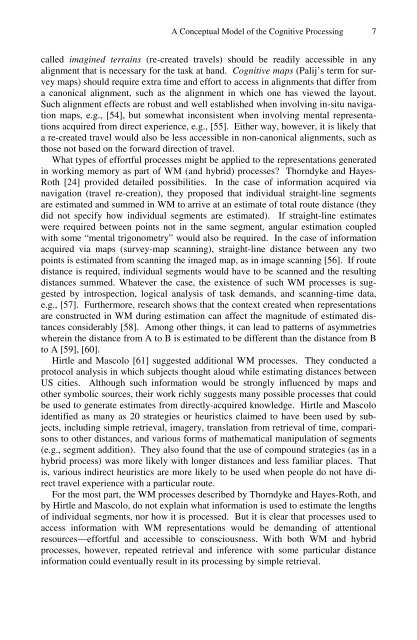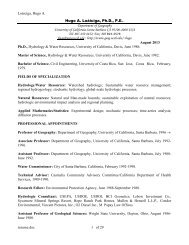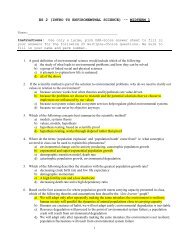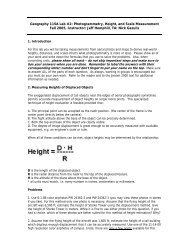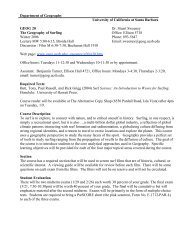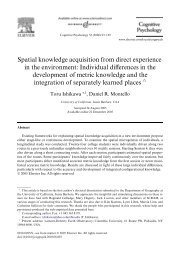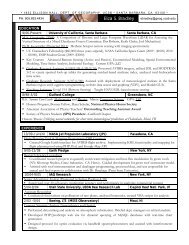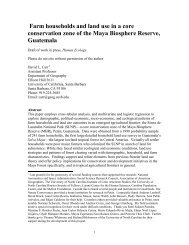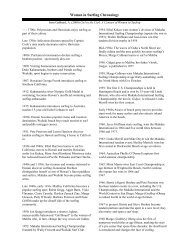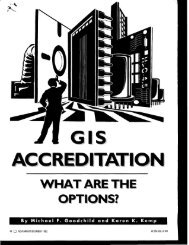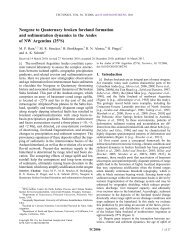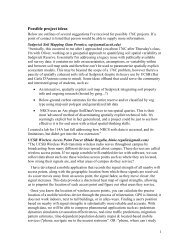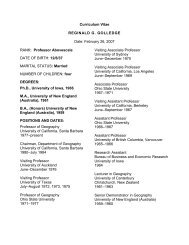A Conceptual Model of the Cognitive Processing of Environmental ...
A Conceptual Model of the Cognitive Processing of Environmental ...
A Conceptual Model of the Cognitive Processing of Environmental ...
Create successful ePaper yourself
Turn your PDF publications into a flip-book with our unique Google optimized e-Paper software.
A <strong>Conceptual</strong> <strong>Model</strong> <strong>of</strong> <strong>the</strong> <strong>Cognitive</strong> <strong>Processing</strong> 7<br />
called imagined terrains (re-created travels) should be readily accessible in any<br />
alignment that is necessary for <strong>the</strong> task at hand. <strong>Cognitive</strong> maps (Palij’s term for survey<br />
maps) should require extra time and effort to access in alignments that differ from<br />
a canonical alignment, such as <strong>the</strong> alignment in which one has viewed <strong>the</strong> layout.<br />
Such alignment effects are robust and well established when involving in-situ navigation<br />
maps, e.g., [54], but somewhat inconsistent when involving mental representations<br />
acquired from direct experience, e.g., [55]. Ei<strong>the</strong>r way, however, it is likely that<br />
a re-created travel would also be less accessible in non-canonical alignments, such as<br />
those not based on <strong>the</strong> forward direction <strong>of</strong> travel.<br />
What types <strong>of</strong> effortful processes might be applied to <strong>the</strong> representations generated<br />
in working memory as part <strong>of</strong> WM (and hybrid) processes? Thorndyke and Hayes-<br />
Roth [24] provided detailed possibilities. In <strong>the</strong> case <strong>of</strong> information acquired via<br />
navigation (travel re-creation), <strong>the</strong>y proposed that individual straight-line segments<br />
are estimated and summed in WM to arrive at an estimate <strong>of</strong> total route distance (<strong>the</strong>y<br />
did not specify how individual segments are estimated). If straight-line estimates<br />
were required between points not in <strong>the</strong> same segment, angular estimation coupled<br />
with some “mental trigonometry” would also be required. In <strong>the</strong> case <strong>of</strong> information<br />
acquired via maps (survey-map scanning), straight-line distance between any two<br />
points is estimated from scanning <strong>the</strong> imaged map, as in image scanning [56]. If route<br />
distance is required, individual segments would have to be scanned and <strong>the</strong> resulting<br />
distances summed. Whatever <strong>the</strong> case, <strong>the</strong> existence <strong>of</strong> such WM processes is suggested<br />
by introspection, logical analysis <strong>of</strong> task demands, and scanning-time data,<br />
e.g., [57]. Fur<strong>the</strong>rmore, research shows that <strong>the</strong> context created when representations<br />
are constructed in WM during estimation can affect <strong>the</strong> magnitude <strong>of</strong> estimated distances<br />
considerably [58]. Among o<strong>the</strong>r things, it can lead to patterns <strong>of</strong> asymmetries<br />
wherein <strong>the</strong> distance from A to B is estimated to be different than <strong>the</strong> distance from B<br />
to A [59], [60].<br />
Hirtle and Mascolo [61] suggested additional WM processes. They conducted a<br />
protocol analysis in which subjects thought aloud while estimating distances between<br />
US cities. Although such information would be strongly influenced by maps and<br />
o<strong>the</strong>r symbolic sources, <strong>the</strong>ir work richly suggests many possible processes that could<br />
be used to generate estimates from directly-acquired knowledge. Hirtle and Mascolo<br />
identified as many as 20 strategies or heuristics claimed to have been used by subjects,<br />
including simple retrieval, imagery, translation from retrieval <strong>of</strong> time, comparisons<br />
to o<strong>the</strong>r distances, and various forms <strong>of</strong> ma<strong>the</strong>matical manipulation <strong>of</strong> segments<br />
(e.g., segment addition). They also found that <strong>the</strong> use <strong>of</strong> compound strategies (as in a<br />
hybrid process) was more likely with longer distances and less familiar places. That<br />
is, various indirect heuristics are more likely to be used when people do not have direct<br />
travel experience with a particular route.<br />
For <strong>the</strong> most part, <strong>the</strong> WM processes described by Thorndyke and Hayes-Roth, and<br />
by Hirtle and Mascolo, do not explain what information is used to estimate <strong>the</strong> lengths<br />
<strong>of</strong> individual segments, nor how it is processed. But it is clear that processes used to<br />
access information with WM representations would be demanding <strong>of</strong> attentional<br />
resources—effortful and accessible to consciousness. With both WM and hybrid<br />
processes, however, repeated retrieval and inference with some particular distance<br />
information could eventually result in its processing by simple retrieval.


